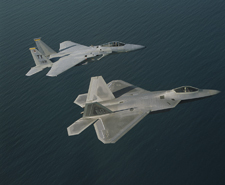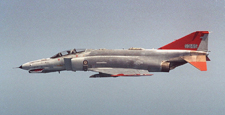|
Beyond the wondrous vista of the shimmering and pristine coastal
waters of the Gulf of Mexico reside two of our nation’s most precious
resources – the oil and gas reserves below and the airspace above.
While the value of further oil and gas exploration to the nation’s
security is commonly known, the value of the airspace is not.
The traditional pillars of economic growth normally incorporate land,
labor and capital. But in Northwest Florida, there is another pillar
that is equally valuable – airspace. It allows not only the flow of
commercial aviation for business and tourism but military training and
testing. Supersonic dogfights, training missions and weapons testing are
conducted by F-15 Eagle and F-22 Raptor fighter jets, as well as other
military aircraft, in specified blocks of airspace. Such exercises occur
at carefully scheduled times to allow pilots unfettered concentration to
scream through the air and hone their combat skills in a deliriously
swirling amalgamation of blue skies, white clouds and emerald waters.
Without undue interference, their mindset is rechanneled to the
challenge – kill or be killed.
But the waters below this airspace are also coveted for their rich
oil and gas reserves by a country seeking energy independence.
 |
The USAF’s F-15 and
F-22 are used extensively in Gulf exercises. Photo courtesy
United States Air Force.
|
Eglin Air Force Base’s Air Armament Center conducts test and
evaluation missions of new weapons involving full-size target drone
aircraft in the skies over the 130,000-square-mile test and training
range in the eastern Gulf – an area larger than the state of New
Mexico. Between Oct. 1, 2007, and Sept. 30, 2008, more than 3,400 test
missions were flown in this airspace.
Any civilian encroachment on this training area could reduce the
military value of Eglin’s mission to test and evaluate new weapon
systems. It isn’t the type of testing that can be efficiently
performed anywhere else in the continental United States.
“The Eglin Water Test Range has more airspace available for testing
new and legacy weapons than the combined airspace of all U.S. land
ranges,” said Bob Arnold, chief of Eglin’s Mission Enhancement
Committee. “This is important due to the increasing safety footprint
size of our new fighter aircraft conducting air-to-air missile tests and
training missions. The increased speed of these aircraft, coupled with
the added range of the missiles, requires larger ‘clear areas’ for
target debris resulting from our testing.”
This range provides training areas for military pilots sharpening
their combat skills from Air Force runways at Eglin, Tyndall Air Force
Base and Hurlburt Field. And the future addition of the new F-35
Lightning II, a state-of-the-art supersonic fighter scheduled to arrive
at Eglin in 2010, will demand even more use of the airspace. The Naval
Surface Warfare Center at Panama City also uses the Gulf waters for
testing and evaluation in the areas of mine warfare, special warfare,
diving and life support.
The combined economic impact of these four installations is $8.9
billion for Okaloosa and Bay counties, according to the Florida Defense
Fact Book published by the University of West Florida’s Haas Business
Center.
Oil and gas drilling operations in the waters of the range cannot
co-exist with ongoing Air Force testing without coordination and a firm
understanding between them. These behemoth rigs cost upwards of $1
billion and incorporate a logistics lifeline to the mainland.
“Our concern over oil/gas activity is related to the possible
damage to oil/gas platforms associated with permanent production
activity,” Arnold said. Moreover, the additional boat and helicopter
support activity would require safe passage, and the radio emissions
from the oil and gas platforms could interfere with military missions.
As part of Eglin’s test and evaluation mission, a fleet of 50
Vietnam-era QF-4 fighter jets are used as remotely piloted, full-sized
target drones, along with smaller drones for missile training and
evaluation by the 82nd Aerial Targets Group operating from Tyndall Air
Force Base.
“Above-surface oil/gas platforms are incompatible with our military
operations in areas of the Gulf of Mexico where we shoot down things
like unmanned drone aircraft,” Arnold said. “Debris from these types
of operations pose a serious safety hazard for the platforms and
personnel who operate them, so obviously, this is not a situation we can
allow to occur.” According to Arnold, the downing of a 25-ton QF-4 can
produce tens of thousands of pieces of debris, with the wreckage hitting
the water with the force of a minivan collision at 45 mph.
Eglin has been working with the U.S. Department of the Interior’s
Minerals Management Service – the agency that manages offshore
drilling – for 25 years on the issue of offshore leases. In a June
2008 meeting, with the Minerals Management Service, the Air Force agreed
to reassess its needs in the test and training range in the eastern Gulf
to accommodate oil and gas exploration, according to a September article
in the Bay Beacon.
“We recognize the importance to national security provided by
oil/gas energy and are working with (the Minerals Management Service) to
accommodate new exploration without impact to our mission,” Arnold
said.
In 2005, Eglin created the Military Mission Line, a demarcation of
its airspace extending south from Hurlburt Field. Military officials say
drilling and exploration on the west side of that line would not affect
training and testing.
A ban on permanent, above-surface structures east of what is now the
Military Mission Line was agreed on in 1986. This affected 95 previously
granted exploration leases sold by the government in that area. For
those leases, Eglin allowed five temporary blocks of time for
exploration, one area at a time. These time blocks shifted every three
months while the military test missions were temporarily moved to other
areas.
Should oil companies want to produce oil or gas platforms resulting
from exploration, they would require a different kind of lease from the
Minerals Management Service that has been coordinated with the military,
according to Arnold. To date, no such requests have been approved.
If production is ever permitted, the Air Force would prefer to see
subsurface technology like that used off the Alabama coast, where
above-surface platforms act as hubs connected to subsurface wells by
pipelines and do not pose a risk to test and evaluation missions.
“We’re perfectly OK with subsurface activity,” Arnold said.
Eglin allowed construction in 2001 of a 36-inch diameter, 419-mile
steel pipeline on the sea bed between Mobile, Ala., and Tampa – a path
that took the project directly through Eglin’s water ranges. The $1.6
billion project provides Floridians with 1.2 billion cubic feet of
natural gas per day without interfering with military missions.
As the debate about drilling in the eastern Gulf continues, the
coordination and communication between the Air Force and the federal
government will continue as it has over the past 25 years as they work
to balance competing needs for exploration and the critical test and
evaluation requirements that serve our national security needs.

|
QF-4 Image courtesy U.S. Air
Force/ Master Sgt. Shaun Withers.
|
Testing the QF-4
The supersonic QF-4 is a reusable, full-scale target drone modified
from the F-4 Phantom. It provides a realistic target for air-to-air
weapons-system evaluation, development and testing for Eglin’s Air
Armament Center.
The QF-4 is a remotely controlled target that simulates enemy
aircraft profiles and maneuvers. The aircraft is launched from a runway
separate from the main operating runway at Tyndall Air Force Base.
The drone can be flown by remote control or with a safety pilot to
monitor its performance. It is flown unmanned when missiles are fired at
it, and only in specific over-water airspace authorized for that type of
flight.
When unmanned, an explosive device is placed in the QF-4 to destroy
the aircraft if it becomes uncontrollable.
The aircraft is equipped to carry electronic and infrared
countermeasures to fully evaluate fighters and weapons flown and fired
against it. Full-scale drone aircraft can be flown totally by computer
using the Gulf Range Drone Control System, or controlled manually during
takeoff and landing using a mobile control station located at the drone
runway. As a safety precaution, a chase plane trails the drone during
critical periods of flight.
The F-4 was the primary fighter-bomber aircraft in the U.S. Air Force
throughout the 1960s and 1970s. F-4s also flew reconnaissance and
“Wild Weasel” anti-aircraft missile suppression missions and saw
considerable action in Operation Desert Storm. Production of the F-4
ended in 1979.
The drone fleet is operated and maintained by the 82d Aerial Targets
Squadron, located at Tyndall Air Force Base. The squadron is a
subordinate unit of the 53rd Weapons Evaluation Group at Tyndall. The
53rd Weapons Evaluation Group reports to the 53rd Wing at Eglin Air
Force Base. – Scott Jackson
|